Tesla Model 3 and Model Y Cold Weather Winter Driving and Charging Tips
Eleven Cold Weather Tesla Tips to Ease Your Range Anxiety and Avoid Getting Stranded this Winter
Here in the Northeastern United States, winter is upon us. And with the extreme cold temperatures come challenges for any car or truck. Just as many ICE vehicle owners plug in their engine block heaters overnight in cold weather, there are several things to consider when driving and charging an electric vehicle during extreme cold weather. My colleague Carolyn Fortuna has chimed in already with some tips for charging an EV in frigid weather. Here are a few additional cold weather tips to keep your Tesla Model 3, Model Y, Model S, Model X or Cybertruck rolling during bouts of extreme cold weather.
Cold Weather Reduces Range and Slows Charging
One thing many Tesla and other EV owners notice during cold weather is that their range is significantly reduced when the mercury drops. If you’re driving long distance, the Tesla navigation system will accommodate for this by routing you to Superchargers more frequently than it does during warmer weather. Don’t rely on the remaining range number on your display as an accurate indicator of your remaining range as this number is based on EPA range ratings and doesn’t take into consideration temperature, grade, wind, climate control use and driving style. The navigation system uses much more conservative range estimates.
I’ve driven across country (New York City to Seattle and back) and up and down the east coast many times during the winter in my Model 3 and can say from experience that there are plenty of Tesla Superchargers along major (and minor) highways. In most areas in the United States and southern Canada, there are more than enough Superchargers to complete virtually any road trip, even in winter. But it’s always good to be prepared for unexpected situations and there are several things you can do in order to maximize your range. Here are eleven tips to make your winter EV road trips safe and stress-free.
Tip #1: Preheat Your Car Before a Trip
Lithium batteries are like humans. They don’t like being cold. Fortunately Tesla has a “Defrost Car” feature that allows you to pre-heat or defrost your car before a trip. And this not only warms up the cabin so the driver and passengers are comfortable but it also warms up the battery getting it closer to an ideal operating temperature. By warming up your car while it is still plugged into your home charger, you can save your battery for the drive and begin that drive in a toasty warm car with a toasty warm battery. If you have a regular commuting schedule, you can schedule the car to preheat the cabin by a specific time and leave for work every day. The “Defrost Car” feature is available in the Tesla Mobile App. You can add it to your Tesla app’s home screen by holding in any of the shortcut buttons and dragging the defrost button to replace one of the other buttons.
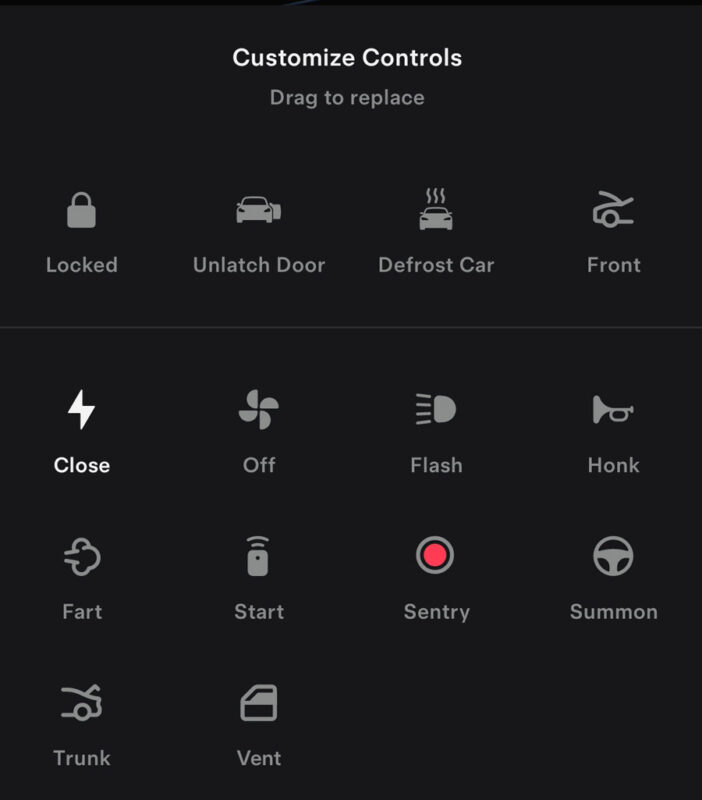
Tip #2: Defrost Your Car Before Clearing Off Snow or Ice
In addition to warming up the cabin and battery, the “Defrost Car” feature is also ideal to use if your car is covered with snow or ice after a storm. After 20-30 minutes of defrosting, most of the snow or ice covering your car will have melted allowing you to easily remove what remains with a brush. This can also prevent your door handles or charging port from freezing up as well.
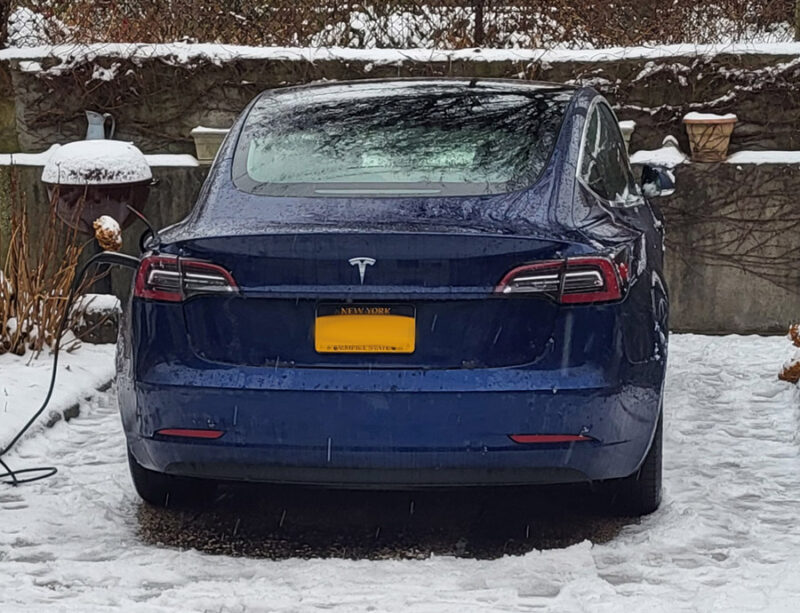
Tip #3: Keep Your Tesla Mobile Connector in the Car on Trips
While the Supercharger network is both extensive and reliable (mostly), it’s always good to be prepared in case of an emergency or unexpected detour. Tesla’s Mobile Connector allows you to tap into any 120V or 240V power outlet and gain anywhere from 4 miles to 35 miles of range per hour. It’s best to keep one in your car in case you get too far from a Supercharger. It’s like keeping a gas can in your ICE car. You may never need it, but it’s nice to know it’s there.
In addition to the Mobile Connector itself, I keep a few plugs and adapters in my car so I can tap into a 240V dryer plug or RV outlet or a 5/20 120V plug for faster charging. I also keep a thick 14-gauge 100-foot outdoor extension cord in my trunk in case of emergency. On a recent road trip, extreme cold weather reduced my range so much that I actually got about 100 yards from a Supercharger when the car shut down. Luckily I was in a shopping mall and a friendly store manager allowed me to plug into her outlet for 15 minutes to get the battery enough charge to make it the rest of the way to the charger. This is a very rare occurrence, but I’m glad I was prepared.
Tip #4: “Navigate to Supercharger”
When the Tesla Navigation system knows you are driving to a Supercharger, it will automatically warm the battery to its ideal charging temperature as you drive. This does use a little bit of battery power to warm the battery, but it will reduce the amount of time needed at the charging station by allowing the battery to charge faster. If you’re on a road trip and you let Tesla plan the route based on charging stops, this will happen automatically. But if instead you select a shopping mall or restaurant or gas station as your destination and plug into a charger at that destination, the battery may need to be warmed a bit while charging and this will likely extend your charging time.
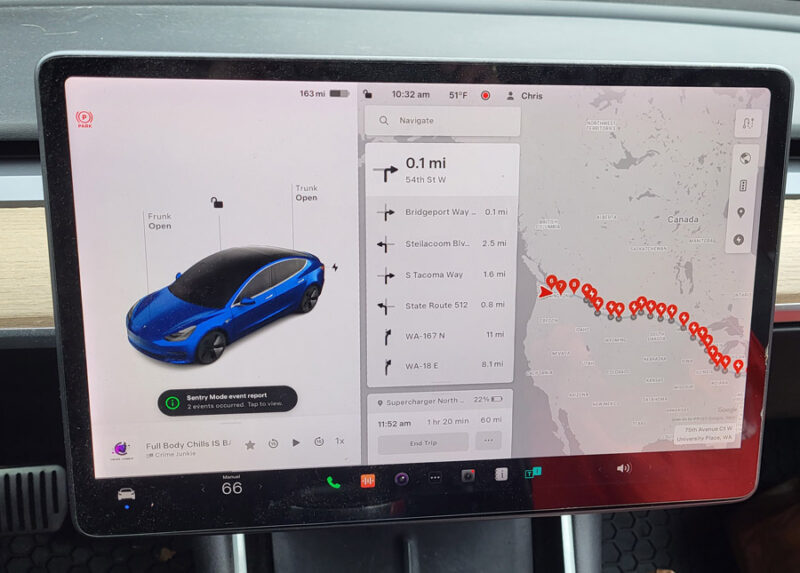
Tip #5: Know How to Maximize Your Range
In most cases, I don’t worry about range at all. I’m able to drive normally (somewhere around the speed limit) in my Tesla, accelerate quickly and set the cabin temperature to 69 degrees (nice). But if you notice that your range is dropping quickly due to extreme weather or cold temperatures, and you’re worried that you won’t have enough battery power to make it to the next charger or your final destination, you can do a few things to reduce battery drain and extend your range.
- Slow Down – Driving at 60 MPH uses much less power than driving at 80 MPH. Also accelerating more slowly will extend your range. You can set your car to “Chill” mode to reduce acceleration or just go lighter on the pedal.
- Use the Seat Heaters, Luke! – Seat heaters are much more efficient than the standard climate control fans and heating elements. Newer Model 3s and Model Ys use a heat pump to heat the cabin more efficiently, but even so, seat heaters are the most efficient way to keep your buns warm. If you drop the cabin temperature by a few degrees and turn up the seat heaters, you can squeeze a little more range out of your battery without making anyone uncomfortable.
- Don’t Navigate to Supercharger – Yes, I know, this contradicts with earlier advice. Normally you want to navigate to a supercharger to warm the battery up before charging, but if you’re in danger of running out of juice, change your navigation to a location *near* the supercharger and this will prevent the car from using battery power to warm the battery while driving. It means you will charge a bit more slowly when reaching the charger (at first), but it will help extend the range a bit if you need those extra few miles.
Tip #6: ABC – “Always Be Charging”
While Tesla recommends capping your daily charge at 80% to extend battery life (except the Model 3 RWD which should be charged to 100% at least once a week), it’s OK to go over 80% charge when you’re going on a trip. Lithium Ion batteries can degrade faster if left at extreme charge levels (below 10% or above 90%) for extended periods. But if you’re about to go on a long drive, or are in the middle of one, it’s perfectly acceptable to charge your battery above 90%. Even if you do cap your battery charge at 80%, it’s best to leave your car plugged in at all times (well, except while driving). By leaving the car plugged in, you can compensate for any loss of range due to the cold or due to background operations like Sentry Mode. If you set your max charge to 80% in the mobile app on the car’s main screen, the car will only draw enough power to maintain that level of charge.
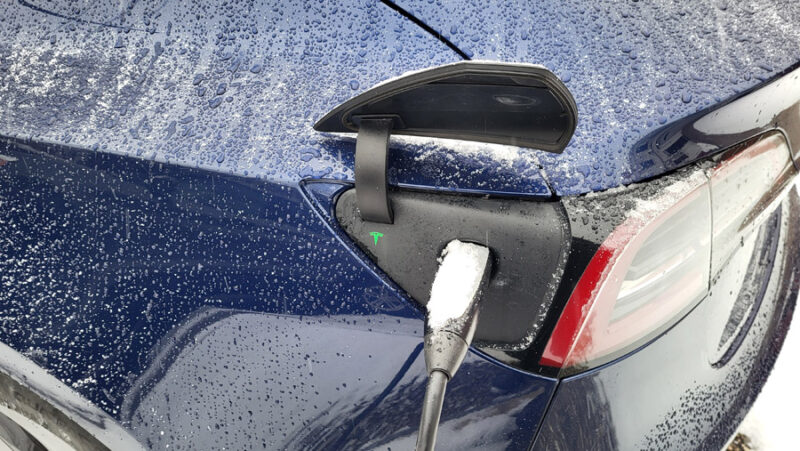
Tip #7: Give Yourself a Buffer
Tesla’s Navigation system is designed to get you from point A to Point B in the most efficient way possible. But if you blindly follow the navigation, you may arrive at a hotel or at a remote mountain cabin with just 10% or less of your range left. The assumption Tesla makes is that you can charge your car at that destination. If it’s really cold outside, your usable range can drop even further overnight which may prevent you from making it to your next stop or to a charger the next day. I usually stay a bit longer at my final charging stop to make sure I arrive at my destination with at least 25% charge. This allows me to keep Sentry Mode active overnight and have a decent charge to start the next day.
Tip #8: Make Sure You Have the Right Tires for the Weather (or Even Chains)
Not specific to EVs, but some new Tesla owners have a rude awakening their first winter when the stock “All Season” tires on their cars don’t hold up well in snow or on ice. Teslas actually handle extremely well on snow, particularly the AWD versions, but tires that are optimized for warm weather use can get stiffer (and less “sticky”) as the temperature drops. Some are not even rated for use below 40 degrees Fahrenheit (4 degrees Celsius). When my stock Michelins needed replacement, I went with a set of Vredestein Quatrac Pro. They handle much better than the stock Michelins did on snow and ice, and they last longer as well. They don’t have great rolling resistance so they’re not the most efficient tire. But personally I’ll sacrifice a bit of range for improved comfort, safety and handling. There are a lot of good choices out there for all weather tires that handle well in the snow so do your research on places like TireRack and Consumer Reports.
Some owners of Teslas as well as other high performance cars who happen to live with harsh winters buy a second set of wheels with dedicated snow tires. These can be swapped in every winter and off every spring. If you’re going somewhere with a lot of snow, consider buying a set of chains and keep these in the car for emergencies. Some roads require chains in certain months of the year, so it’s best to do your homework if you’re going to be visiting areas with lots of snow. Note that you normally only need chains on the rear wheels, even on an AWD model. Having chains on the front wheels can potentially cause rubbing while turning if you don’t have enough clearance.
Tip #9: Stay at Hotels with Destination Chargers Where Possible
If you’re taking a multi-day road trip, staying at a hotel with a level 2 charger available can shave off one of your supercharging stops. Just be sure to ask the hotel in advance if you need to reserve a spot and if the spots are actually reserved for EVs. We’ve heard from some weary travelers that they arrive at their hotel only to find the EV charging spots blocked by ICE cars. Many hotel web sites will list EV charging as an amenity, but you can also use the PlugShare app or web site to find hotels with EV chargers. The PlugShare app is also handy if you’re far from a Tesla supercharger and want to find other Level 2 and Level 3 charging options nearby.
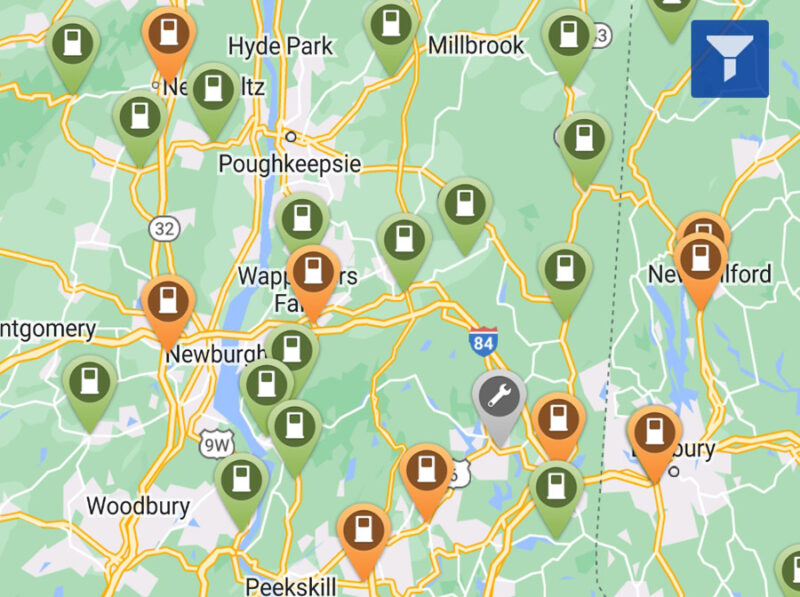
Tip #10: Spray Some WD-40 (or lock de-icer) into Those Funky Flush Door Handles
Tesla’s door handles are flush with the car body for a reason: aerodynamics. By eliminating the air drag of door handles you can increase the car’s efficiency, thereby increasing range. Other EV makers like Hyundai have copied this flush design for the same reason. But the flush design of the Model 3 and Model Y door handles can lead to the handle getting frozen stuck in extreme cold weather a bit more often than traditional door handles. As a preventative measure, you can spray some WD-40 or lock de-icer inside the door handles to prevent them from freezing. In most cases, defrosting the car in advance through the app or scheduling will prevent the handles from locking up. But if that doesn’t solve the problem, you can use the side of your fist to loosen the ice (knock around the whole handle a few times in a circle) and by pushing in on the front and back of the handle to loosen it up. If a frozen door handle or charge port door happens to you, you can also use a Ziploc bag with hot water in it, some windshield de-icing spray or a hand warmer to thaw it out within a few minutes. I always keep a spray bottle of Prestone De-Icer in my trunk when traveling in winter.
Tip #11: Keep Some Handwarmers in Your Glove Box
Handwarmers are a good thing to keep in your car for a number of reasons. One, to keep your hands warm if you find yourself working outside for a while, But they can also be used to address some Tesla specific issues. Handwarmers can be used to thaw a frozen door handle or charge port door, or to unstick a frozen charge port latch. Early versions of the Model 3 (2017-early 2020) are more susceptible to having their charge port latch freeze and become inoperable in extreme cold weather. In early 2020, the company added a “charge port inlet heater” to the Model 3 and to the Model Y. So if your car is from 2020 or newer, using the “Defrost Car” feature will directly warm up your charge port latch as well, preventing it from getting stuck. But if you notice that you get a flashing yellow or red light next to your charge port (instead of a blue or green light) and hear a repeating mechanical clicking sound when attempting to connect a charging cable to your car, it’s possible that your charging port latch is frozen stuck. In this case, you can insert a hand warmer pad into the charge port area for a few minutes to thaw the charge port.
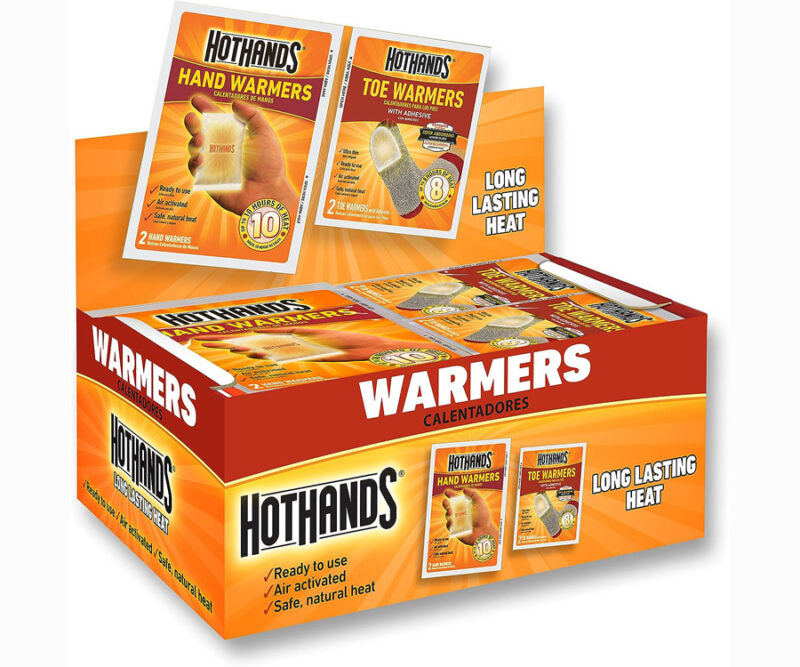
But there’s an even more useful purpose for a hand warmer. One of the main issues that led to the much-hyped failure of the Chicago area Superchargers earlier this year was that the Supercharger cables were falling out of their holsters and into the snow. This can happen during extreme cold weather as the cable on older V2 Superchargers stiffens up and this causes the cable end to fall out of its holster and onto the ground. If the charging cable falls into snow, the end of the cable can get packed with snow, causing it to fail to connect when you try plugging it into your charge port. This can make it seem as if the Supercharger is not operational. Some Tesla owners in the Chicago debacle figured out that they could thaw out the charging cable by putting it near their heater vents for a few minutes, and once thawed, the Supercharger worked as expected. But if you’re low on battery and don’t want to crank up your heater, a hand warmer can serve the same purpose. Just wrap one around the end of the charging cable for a few minutes, shake out the melt and charge away. Here’s a 10 pack from Amazon.
With a little preparation and understanding of how cold weather can affect your EV driving and charging, you can stay safe and warm and fully charged during your winter travels.
Got your own cold weather EV travel tips and suggestions? Let us know in the comments.
Considering a Tesla? Use my referral link for a bonus on your purchase or Schedule a Demo Drive at a location near you.
Related Reading:
The Art of Charging an EV in Frigid Cold
How to Help Your EV Have More Range in the Winter
The Art of Driving Electric Cars in the Cold
Tesla Winter Essentials: Don’t Leave Home This Winter without These Ten Items
Have a tip for CleanTechnica? Want to advertise? Want to suggest a guest for our CleanTech Talk podcast? Contact us here.
Latest CleanTechnica.TV Video

CleanTechnica uses affiliate links. See our policy here.

